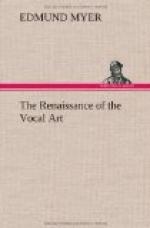The special object of this exercise is to relax the jaw, the face, and the throat muscles. A stiff, set jaw always means throat contraction. In this exercise, if sung in every other respect according to directions, a stiff jaw would defeat the whole thing, and make impossible a correct production of every high tone.
In singing the la sound, the tip of the tongue touches the roof of the mouth, just back of the upper front teeth. Think the tone forward at this point, and let the jaw rise and fall with the tongue. Devitalize the jaw and the muscles of the face, move up in a free, flexible manner to the level of every tone, and you will be surprised at the freedom and ease with which the high tones come. The moving up in the proper way applies strength, and secures automatic form and adjustment; develops or strengthens the resisting or controlling muscles of the voice; in fact, gives the voice expansion, inflation, and tonicity.
Remember that one can act in singing; and by acting I mean the movements as here described, lifting, expanding, etc., without influencing the voice or the tone, without applying the movements to the voice; of course such action is simply an imitation of the real thing. Herein, however, lies the importance of correct thinking. The thought must precede the action. The singer must have some idea of what he wants to sing and how he wants to sing it. A simple chance, a simple hit or miss idea, will not do. Make your tone mean something. Arouse the singer’s sensation, and you can soon tell whether the movement is influencing the tone or not. Of course these movements are all more easily applied on the middle and low tones than on the higher tones, but these are the great successful movements for the study and development of the high tones.
As we have learned in our former publications, there are but three movements in singing,—ascending, descending, and level movements. We have so far studied ascending and descending movements or arpeggios. We will now study level movements on a single tone, thus:
[Illustration: THIRD STUDY. Ah.]
Place yourself in a free, flexible manner upon a level with the tone by the use of the movements as before described; lift, expand, and let go without hurrying or without hesitation, and just when you reach that which you feel to be the level of the tone let the voice sing. All must be done in a moment, rhythmically and without local effort. Sing spontaneously, sing with abandon, trust the movements. They will always serve you if you trust them. If you doubt them, they are doubtful; for your very doubt brings hesitation, and hesitation brings contraction. Sing from center to circumference, with the thought of expansion and inflation, and not from outside to center. The first gives freedom and fullness of form, the latter results in local effort and contraction. The first sends the voice out full and free, the latter restrains it. Expansion through flexible movement is the important point to consider. When the tone is thus sung, it should result in the removal of all restraint, especially from the face, jaw, and throat. In this way the tone will come freely to the front, and will flow or float as long as the level of the tone is maintained without effort.




